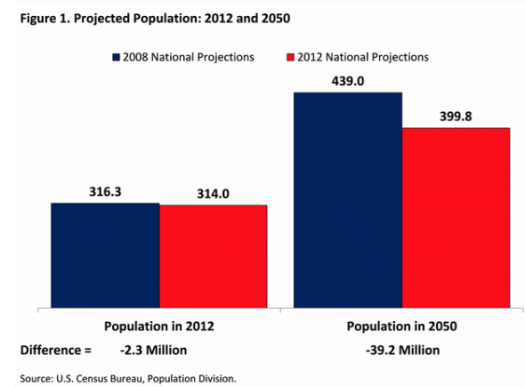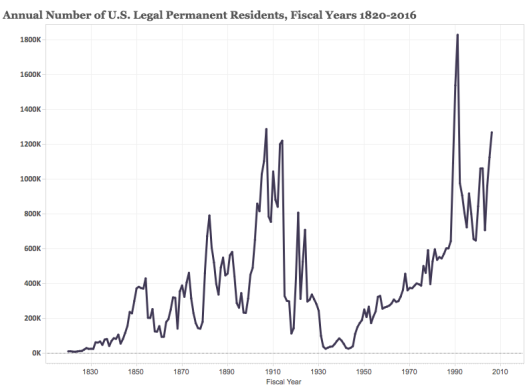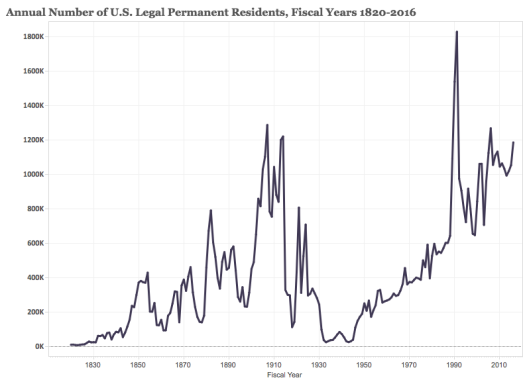50 million Americans are missing (in 2050)
One of the big mysteries is why the housing market crashed after 2006. The later part of the crash (2008-12) was obviously partly due to the Great Recession. But what about 2006-08? I’ve occasionally argued that a decline in expected immigration may have played a role. Here are some census estimates of the US population in 2050, first made in 2008, and then in 2012:
 That’s a striking decline in just 4 years. More recently, the Census Bureau has further reduced their 2050 estimate, to 388 million. (Current population is 328 million.) And while part of the explanation is falling birth rates, immigration seems to be the main story:
That’s a striking decline in just 4 years. More recently, the Census Bureau has further reduced their 2050 estimate, to 388 million. (Current population is 328 million.) And while part of the explanation is falling birth rates, immigration seems to be the main story:
A comparison of the bureau’s 2008 and 2012 projections for the year 2050 indicates that most of the 39.2 million gap in the total population forecast is due to scaled-back assumptions about the level of new immigration to the U.S. But another notable factor in the lowered population projection was that the bureau also lowered its forecasts for birth levels.
Ignoring the amnesty bulge in 1990-92, US immigration levels peaked in 2006, at over 1.26 million per year (close to the earlier 1907 peak). At this time, there was also a high level of illegal immigration, including Mexican workers drawn in by the housing boom. Total immigration might well have been close to 2 million per year. It looked like immigration was about to push America’s population much higher.
All that changed after 2006. Bush’s push for immigration reform (which would have boosted immigration levels) failed in Congress. Border security was tightened and the net level of illegal immigration from Mexico slowed to almost zero. Not just due to tighter border security, but also a weaker economy in the US and relatively better prospects in Mexico. (Also lower Mexican birth rates.) Now net immigration is probably closer to 1 million/year, although it’s hard to be certain.
The massive wave of expected immigrants was disproportionately pouring into the “sand states”, such as southern California, Nevada, Arizona, Texas, and Florida. With the exception of Texas (which never had a house price “bubble”) those areas were the epicenter of the housing crash. I am not saying that the immigration slowdown was the only factor. I’ve already mentioned the recession, and tighter lending standards also played a role. Maybe there really was a bubble. But I don’t see how such a massive drop in expected population growth could not have played a significant role, especially in the states that were expected to receive those immigrants.
Over at Econlog I have a related post. It punctures two myths:
1. The myth that immigration is making America more diverse. (We’re going to stay about 75% “white”).
2. The myth that immigration is reducing the share of Americans who vote Republican.
Check it out.
PS. I’m not sure why I didn’t know this, but it’s really quite interesting:
The Immigration Act of 1924, or Johnson–Reed Act, including the National Origins Act, and Asian Exclusion Act (Pub.L. 68–139, 43 Stat.153, enacted May 26, 1924), was a United States federal law that set quotas on the number of immigrants from certain countries while providing funding and an enforcement mechanism to carry out the longstanding (but hitherto unenforced) ban on other non-white immigrants. The law was primarily aimed at further decreasing immigration of Southern Europeans, countries with Roman Catholic majorities, Eastern Europeans, Arabs, and Jews.[1][2][3][4] The law affirmed the longstanding ban on the immigration of other non-white persons, with the exception of black African immigrants (who had long been exempt from the ban). Thus, virtually all Asians were forbidden from immigrating to America under the Act (subsequent court rulings would determine that Indians were not white and could not immigrate).[citation needed]
Contrary to popular belief, Latin Americans were not prohibited or limited from immigrating under the law. In most states and under federal law, persons of mixed white and Native American ancestry were considered white; this principle was interpreted under the Act to allow Latin Americans to immigrate as “white persons.” Moreover, unlike Eastern and Southern Europe, no nationality-based quotas were placed on Latin American immigrants. Thus, the law allowed unlimited Latin American immigration, just as it allowed unlimited northwestern European immigration. Ironically, the 1965 immigration law that replaced the 1924 Act, though abolishing racial preferences and national quotas, would effectively place greater restriction on Latin American immigration.
So the racist immigration bill of 1924 (I’m not being sarcastic, it was racist, as people defined “race” at the time) favored blacks and Hispanics over Eastern and Southern Europeans? Can someone confirm the accuracy of this Wikipedia post? This means the 1965 bill did not have the effect that everyone seems to think it had, as the immigration surge after 1965 was mostly from Latin America (until recently). And what about when Eisenhower expelled illegal Mexican workers?
PPS. Below I have a graph of immigration up to 2006, when it seemed to be exploding (mentally block out the 1991 spike to see the trend), and then another showing immigration up to 2016. (2017 data, not shown, showed a slight slowdown from 2016):
Tags:




1. July 2018 at 11:07
Interesting
1. July 2018 at 13:58
“Fifty years from now America will still be about 75% “white”, in terms of people’s perceptions.”
Not a chance. The U.S. of 2068 will be something like Florida today. Florida is not 75% White.
Political party control will, however, remain essentially random.
There is no doubt Hispanics and Asians will push America to the left. However, there’s more evidence it’ll be socially left than economically left. Hispanics and Blacks never voted a majority for same-sex marriage in any U.S. referendum, but there is no doubt their loyalty helped the Democratic Party move socially to the left on the issue.
1. July 2018 at 14:05
Also, Sumner, I think the housing construction collapse caused the immigration collapse, not the other way around.
1. July 2018 at 16:24
Great post. I also had no idea that the horrid 1924 immigration act excluded, that is favored, Latin Americans and blacks.
BTW the United States produces about 1.3 million new housing units every year. I do not know the number that become abandoned or dilapidated.
Something to ponder when considering immigration rates.
1. July 2018 at 17:36
It is hard to see any trend from the 1965 immigration Act.
1. July 2018 at 17:37
‘Trend effect’ that should be.
1. July 2018 at 17:45
@Benjamin Cole
The 1924 immigration act almost entirely banned African immigration. So it did not favor Blacks. Just Latin Americans.
http://historymatters.gmu.edu/d/5078
1. July 2018 at 19:05
Harding, So Wikipedia is wrong. Someone needs to correct that.
I’m still curious about the Latin American angle. How did Eisenhower expel lots of Mexican workers in the 1950s?
On housing, causation went both ways.
1. July 2018 at 22:27
e Harding: Presumably, Latin Americans were in the quota of 1,100 for countries in the “All others” catch-all?
2. July 2018 at 10:21
Scott,
It is generally reported that the collapse in home construction caused Mexican immigration to dry up. I would be interested to see more evidence proving causation.
America has a housing shortage and will for many years. So I don’t believe the problem is with construction firms. Rather, there just isnt land left in desirable places (San Francisco, Manhattan, etc).
2. July 2018 at 13:42
Benny, Actually there is plenty of buildable land, the problem is tight zoning rules. In places where zoning is less of a problem (say downtown Chicago) new housing can be built far more cheaply.
I live in Orange County, which could produce another million houses if they’d allow it.
3. July 2018 at 05:32
It’s pretty likely that yes, whiteness will broaden some more: I’d argue that some kinds of Asians are already white in practice. That said, how could this fail to happen? Mainly by keeping institutions relatively undemocratic, and the bonus overt racism that we are seeing in public discourse entrenching itself.
The concentration of population in not just populous states, but populous metro areas seems to be, if anything, accelerating, and with it, the concentration of wealth that doesn’t go along with increased political power. The Supreme court is full of “right wing” (of the worst kind, those that think that the people that are oppressed are religious whites) judges that seem uninterested in things like representation. The senate will keep becoming less democratic without very difficult, unlikely reforms. A country ruled by minorities that like to separate themselves from the majority is not that uncommon, and it doesn’t solve itself easily.
3. July 2018 at 14:57
Scott,
I hear that argument a lot. I’m not so sure anymore. Even in Chicago, with less restrictions and more open land, prices are soaring much faster than inflation. I suspect that building further out isn’t feasible for most cities as further out is already developed and the edge is so far that commute times are unbearable.
An issue that concatenates is the enormous costs of building subways in America and the legacy costs many old cities face from pensioners.
6. July 2018 at 08:16
(memorial comment)